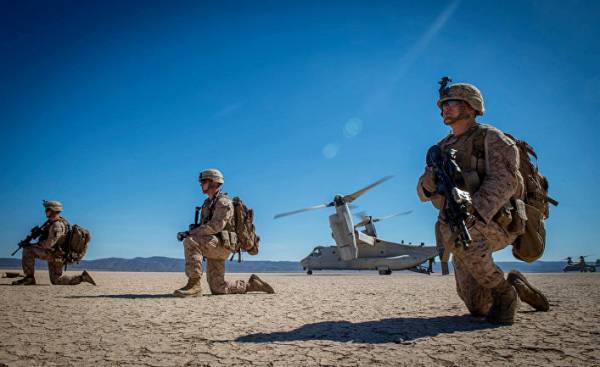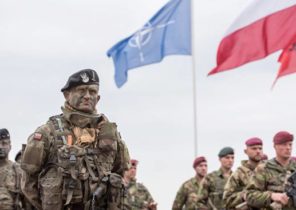
If you want to see how radically changed the military, you should visit the workers in our aircraft scattered around the world buildings, their Windows resembling warehouses. They run a system called “Distributed Intelligence System” (Distributed Common Ground System) — army name for the vast network that provides information in real time for serving military aviation analysts. They round-the-clock support relationship with the us military in the campaign against the “Islamic State” (banned in Russia as a terrorist organization — approx. interpreter), at the same time, tracking hot spots around the planet.
However, as revolutionary as these network intelligence station, they probably get old. At the moment, we model their hardware and software systems for cloud applications. When I talked about this with the soldiers, the young Aviator told me that you have already created an application that is able to do his work — analysis and stocktaking of intelligence information. Then he joked that calls their application “the Wall” because every time he tries to put it into use, it rests in bureaucratic deadlock.
A couple of the young Aviator expressed the approach that we must radically alter if we hope to preserve American military superiority. In the example given by me, though private, but reflecting, I think, the overall situation, Aviator is many are willing to innovate young people. However, too often prevents them adopted a way of life.
Now more than ever it is important to give these young inventors the opportunity to Express themselves, while the Ministry of defence is trying to find a decent answer to the enemies, step by step, reducing our technological advantage. Obviously, in my opinion, that in the information age superiority over the enemy will require something more than just technological breakthroughs. We need to change the attitude of people like developed the “Wall” Aviator, and to help technically advanced young soldiers who will ensure our long-term progress.
The army needs to create a kind of “ecosystem” for innovation that will nurture people, ideas and technology for the common good. In the course of American history, these ecosystems have appeared in different places and industrial areas, including Detroit (mass production), new Jersey (research), Hollywood (entertainment), and from recent examples, Silicon valley (information technology). If the Ministry of defence expects to outsmart our opponents, we need to rethink the relationship between people, ideas and technology.
For decades, we have improved one of our rivals the game instead of having to change its rules. Drawing Parallels with pop culture, we tried to play better football instead of start playing Quidditch, aggressive sport of the books about Harry Potter. It is time to unleash the young inventors in our army, so they developed a decent Google or Facebook smart application and looking for the best ways to manage or prevent war.
Improving technologies has indisputable value, but we should keep caution, because mere military hardware is unlikely to provide us with a decisive advantage. Anyway, our rivals will catch up with our developments long before they are commissioned. This does not mean that the equipment does not need to develop, however, we should bear in mind that information technology has gained such importance, that in itself modern equipment is unlikely to guarantee us victory over the enemy States and their agents.
Given these new challenges, what should be the ecosystem, which will change the rules of the game? Despite protests from conservatives, we need to transform military units into a kind of Silicon valley startups. It is not about fancy seats and capsules for sleep. I mean the approach to startups connections between people, ideas and technologies.
First, the army needs to invest more effort and resources to the development of personal talents. Head of innovative organizations like Google nurture and develop the talent, as they realize that innovation happens at a fundamental level. We need to transform military units into a place where young speaks will find new opportunities and connections. At the moment my two Aviator included in the Experimental unit of the Defense Innovation (Innovation Unit Defense Experimental) — an Outpost set up by the Ministry of defence in Silicon valley to work with the best commercial technologies in the world — where they create apps for our field units. In my opinion, exactly such opportunities, we must ensure at the global level.
Second, we need to change the organization and modus operandi of many units. In the innovation centers of America employees represent their organizations as Venn diagrams, rather than vertical graphs. In Silicon valley, the intersection on the graph are a source of new opportunities and the engine of innovative thinking. Military organizations too often operate to the chamber, working on projects in isolation and the strict bureaucratic requirements.
In his book, “Detachment of troops” (Team of Teams), General Stanley McChrystal (McChrystal) writes about how his percussion group were United by the principle of intelligence and operatives, thereby rapidly destroyed a formidable intelligence network Zargawi in Iraq. The Ministry of defence to introduce a similar order in all branches of the armed forces to the Marines and the pilots of the F-22 could engage in brainstorming on a par with specialists in electronics and intelligence analysts and to act more flexible than our opponents. Exactly and doing the “combat specialists”, which the BBC recently posted in the middle East to fight Islamic State.
Finally, brainstorming is not enough if these young people will not be able to quickly apply their ideas in practice. Modular hardware design, applications and networks that allows to update directly from the field, will have on the ecosystem of key importance. The Ministry of defence to provide soldiers access to a programming interface that allows you to create applications to run certain programs. When you create something from the aircraft to the programs, the army needs to go from awkward a planned development to “development platforms” that allow inventive soldiers how to adjust military technology and equipment to suit your needs.
Of course, the modularity and software interfaces involve some risks. However, a centralized system of protective measures that we use to work with information technology, slows and binds the entrepreneurial spirit of our young innovators. This policy calls into question our ability to develop new technologies fast enough to respond to the challenge. Last year, the air force funded the state owned network with an open architecture for departments like ours, enabling cloud programming, accelerated application development and machine learning. We need to take the next step and create an ecosystem that will be able to take advantage of such a network, because in the near future, win or lose will depend on how quickly young military minds will be able to develop software to integrate data and use artificial intelligence.
The army gave America the Internet and GPS; broke the sound barrier and built a global intelligence network, ensuring the security of our nation. We remain the most powerful and technologically advanced army in the world. However, to become complacent and rely on technology that copy our opponents, is not enough — it is time for a new beginning. The spark of innovation burns brightly especially among the young military. Military services will always appreciate and cultivate discipline, discipline, health and other properties. The Ministry of defense should also appreciate and the ability to innovate in the ranks of their employees.
Air force Colonel Jason M. brown in command of 480 Wing Intelligence, surveillance and shadowing, located in the joint base Langley-Eustis in the state of Virginia.
The following views do not necessarily Express the views of the U.S. air force or Department of defense.







